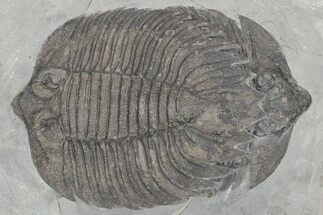This Specimen has been sold.
2.8" Rare Double Trilobite (Radnoria) Plate - New York
This is a plate of two scarce, Silurian-aged, proetid trilobites (Radnoria sp.) from the Rochester Shale of Middleport, New York. One of the trilobites is ventral while the other is beautifully prone. They measure .58" and .45" wide and are nicely centered on a 2.8 x 2.5" slab of shale.
It comes with an acrylic display stand.
The right (anatomically) genal spine of the ventral trilobite has been restored. There are some spots of restoration along the edges of the prone trilobite, making up approximately 4-5% of the specimen.
It comes with an acrylic display stand.
The right (anatomically) genal spine of the ventral trilobite has been restored. There are some spots of restoration along the edges of the prone trilobite, making up approximately 4-5% of the specimen.
About Trilobites
Trilobites were a very diverse group of extinct marine arthropods. They first appeared in the fossil record in the Early Cambrian (521 million years ago) and went extinct during the Permian mass extinction (250 million years ago). They were one of the most successful of the early animals on our planet: over 25,000 species have been described, filling nearly every evolutionary niche. Due in large part to their hard exoskeletons (shells), they left an excellent fossil record.
Trilobites were a very diverse group of extinct marine arthropods. They first appeared in the fossil record in the Early Cambrian (521 million years ago) and went extinct during the Permian mass extinction (250 million years ago). They were one of the most successful of the early animals on our planet: over 25,000 species have been described, filling nearly every evolutionary niche. Due in large part to their hard exoskeletons (shells), they left an excellent fossil record.
SPECIES
Radnoria sp.
LOCATION
Caleb's Quarry, Middleport, New York
FORMATION
Rochester Shale
SIZE
Trilobites: .58" and .45", Rock: 2.8 x 2.5"
CATEGORY
SUB CATEGORY
ITEM
#295532
We guarantee the authenticity of all of our specimens.
 Reviews
Reviews











